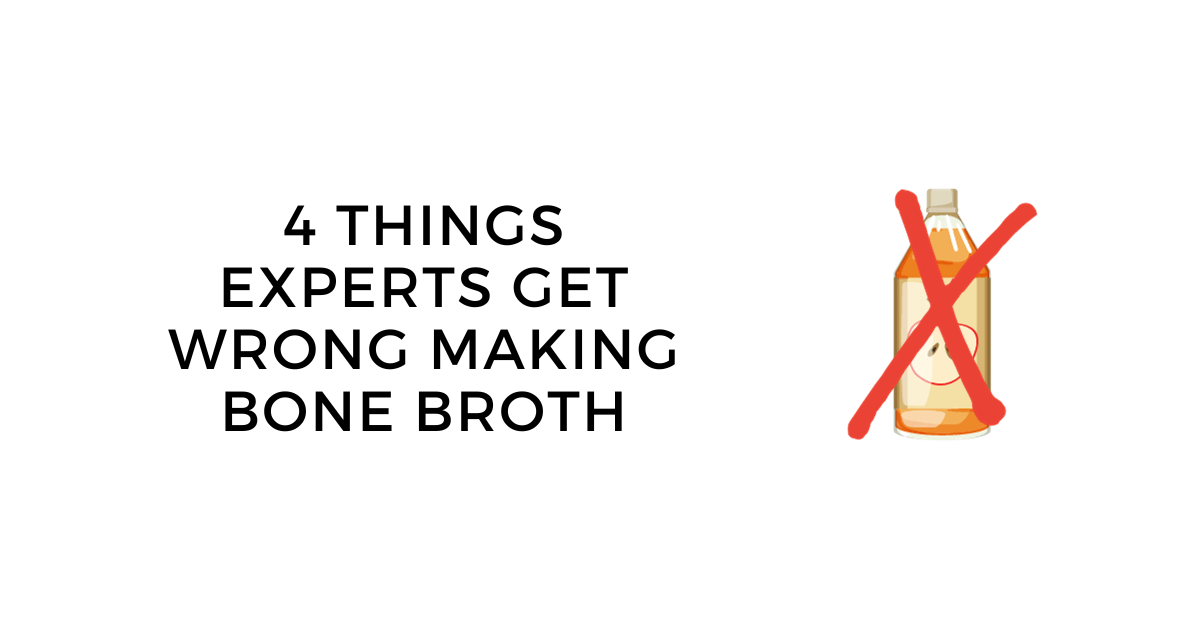
Apple Cider Vinegar in Bone Broth: And 4 Mistakes You're Making
Apple Cider Vinegar in Bone Broth
I get questions all the time on how to make a simple yet delicious bone broth. After years of making it daily, I’ve learned what works and what doesn’t.
The worst part is that all the recipes and info you read online is mostly wrong. Blogs and news sites tend to post the same misinformation on how to make crappy bone broth or bone broth vinegar.
I’m not sure where some of these mistakes started but I see most internet marketer food expert types peddle the same info on bone broth. It’s all wrong.
As a result I constantly get the same troubleshooting questions from friends and customers alike.

This article will go through the 4 things every supposed expert and website gets wrong about making bone broth. Ready? Let’s go!
Mistake #1: Adding Apple Cider Vinegar
Everyone and their mother thinks you should be adding apple cider vinegar or some type of acid to your bone broth.
Acid is typically added at the beginning with the water. Perhaps these armchair quarterbacks even recommend letting the bones sit with the acid in cold water for 30-60 minutes before turning on the heat.
Read the definitive list of bone broth brands you can trust.
The thought is that acid helps draw out nutrients from the bones even before you start simmering the bone broth.
What these charlatans and bloggers haven’t done is lab tested as much bone broth as I have. We send our bone broth for lab testing twice a year for vitamin and nutrient analysis, amino acid profiles and nutrition facts.
I suspect this is where some of the misconceptions around nutrient content in bone broth comes from. Similar uninformed bloggers peddle the notion that bone broth is rich in calcium. After all, it is made of bones, isn't it?
This is completely wrong. Look on the back of any bone broth and you’ll see at most 5% of your daily calcium per serving.
We’ve directly compared two batches of our bone broth for nutrients and vitamins. The first batch is made with apple cider vinegar, while the second without.

Guess what? There was no significant difference in vitamin and mineral content. A few percentage points here and there with respect to iron, calcium and vitamin C.
It is important to put things in context in terms of nutritional benefits to you. While 10 mg vs 12 mg is a 20% increase, it amounts to nothing in your daily intake of calcium.
Let me explain why. The recommended daily intake for calcium is 1000 mg.
10 mg serving represents 0.5% of your recommended daily intake.
12 mg serving represents 0.6%
If you want to save time and money in your homemade broth, I would argue it is a waste to use ACV to get an extra 0.1% of your daily intake.
But if you still prefer using it, then go for it.
Bone broth is not about the vitamins and minerals. It is about the gelatin, collagen, glucosamine and proteoglycans.
Next time you make bone broth, skip the apple cider vinegar. Your money is better spent elsewhere. If you do insist, you will end up with bone broth vinegar.
Read our secret recipe to making bone broth.
Mistake #2: All about the HEAT!

How hot should you cook your bone broth? Lots of websites encourage you to look for the perfect low simmer with the occasional bubble surfacing every couple seconds.
This is a recipe for weak broth with no gelatin and thus no nutritional benefit.
You should think of making bone broth as harvesting collagen and gelatin from bones and connective tissue. You need heat to harvest collage and gelatin in an efficient manner.
A low simmer will still work, but your cook time will be significantly longer. Perhaps two days at a lower temperature. Why wait when you can have it done quicker?
We recommend cooking your bone broth as hot as you are comfortable with without the broth spilling over your pot. If you have a thermometer, I’d recommend 98 degrees celsius.
This is a hard rolling simmer with lots of bubbles popping up. Don’t be afraid of letting it boil from time to time as well. Especially if you are home and able to watch over it every hour or so. If you go out or go to sleep, better to turn down slightly to 95 or 96 celsius.
With this temperature, you can make a collagen rich chicken bone broth in 10-12 hours and beef bone broth in 16-18 hours.
If you’re using a crock pot or slow cooker, then heat on high with the lid on. On the stove it is better to keep the lid off. Since you can achieve a higher temperature, the lid is not needed.
Moreover leaving the lid off lets the broth reduce naturally which results in more gelatinous and concentrated bone broth. If you notice it reduces too much, you can always add more water to the level you started with.
If you just want to try one and not obsess over making the best one, then read my guide on where to buy bone broth.
Mistake #3: Bones to Water Ratio
It takes a lot of bones to get that nice gel in your bone broth. This is where the big misconception around high prices for bone broth comes in.
Bones are expensive, and you need more than you’d think to make bone broth. This translates into why bone broth is not inexpensive these days, though we are working to change that.
So how many bones do you need for properly gelly bone broth? Think of your pot filled with bones as a cup filled with ice. You add water to the ice which fills in the nooks and crannies. The ice is the bones you’re using in this case.
For chicken bone broth we recommend 1.4:2 ratio of bones to water. If you have access the chicken feet to mix in with your chicken bones, then the ratio is closer to 1:2 bones to water (ex: 1 KG of bones per 2L of water).
For beef (or other ruminants) bone broth the ratio is closer to 1:2 bones to water, although this greatly depends on the type of beef bones you’re using.
Your mileage will vary depending on the bones you use, so best to experiment with a smaller batch before testing a larger one. There is nothing worse than finishing a lengthy simmer only to find you have average bone broth for your efforts.
Mistake #4: Poor Skimming Practises
Yes I’m calling you out for poor skimming practices. The first 1-2 hours of cooking bone broth is crucial as it sets the stage for the whole batch.
If you neglect skimming the fat, foam and impurities as they rise, you may end up with cloudy broth. There is nothing wrong with cloudy broth. In fact, this is how certain culinary cultures (Korea and Japan) prefer to make protein rich broths
This happens to the best of us. In our early days we had to pour out full batches of bone broth once or twice due to cloudy and murky broth. You know it when you see it. It looks like milk.
This is mainly due to not skimming properly, but also from stirring bone broth during the cook. Do not stir it, ever.
Take pride in skimming all the foamy bits every 20 minutes or so for the first 1 hour or however it takes to boil the broth for ten minutes or so. It is quite relaxing. After that you are good to go!
“Homemade broth, of course, is a whole food product. It’s a slow food, whole food, and real food that has been nourishing and healing people for tens of thousands of years.”
― Sally Fallon Morell, Nourishing Broth: An Old-Fashioned Remedy for the Modern World
Bottom Line
There you have it, 4 mistakes many people make when getting started making bone broth.
If you are considering purchasing bone broth then make sure that you find a quality product. The best one in my mind is the chicken bone both powder from Bluebird Provisions.
You can find it on Amazon prime for free shipping.
Have you made bone broth? Leave a comment and let me know how it went!
Sources:
(1) https://pubmed.ncbi.nlm.nih.gov/2592713/
(2) http://www.ncbi.nlm.nih.gov/pmc/articles/PMC1975347/
(3) http://jn.nutrition.org/content/7/5/535.full.pdf
(4) http://www.ncbi.nlm.nih.gov/pubmed/8082052
(5) https://www.ncbi.nlm.nih.gov/pmc/articles/PMC5533136

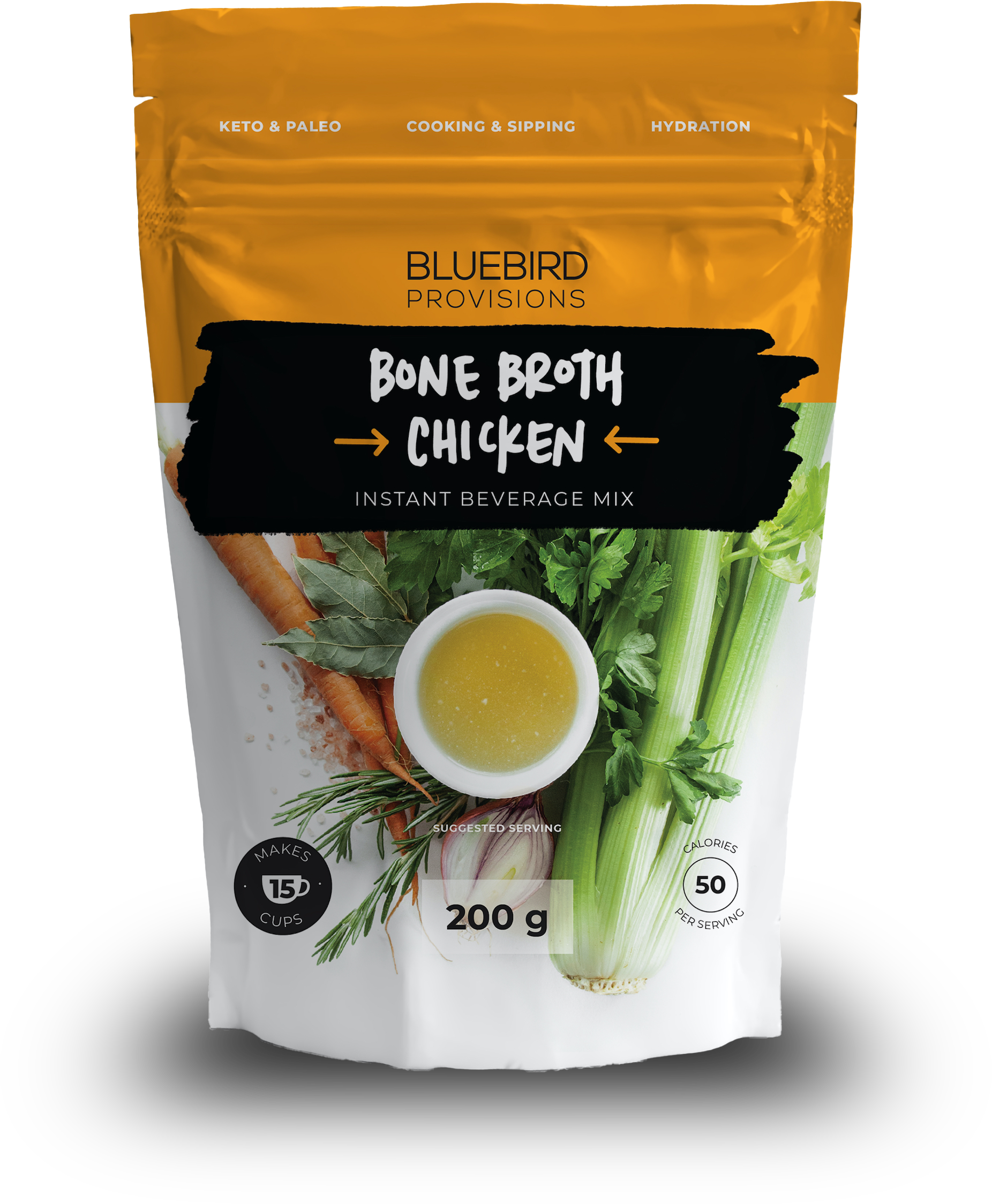

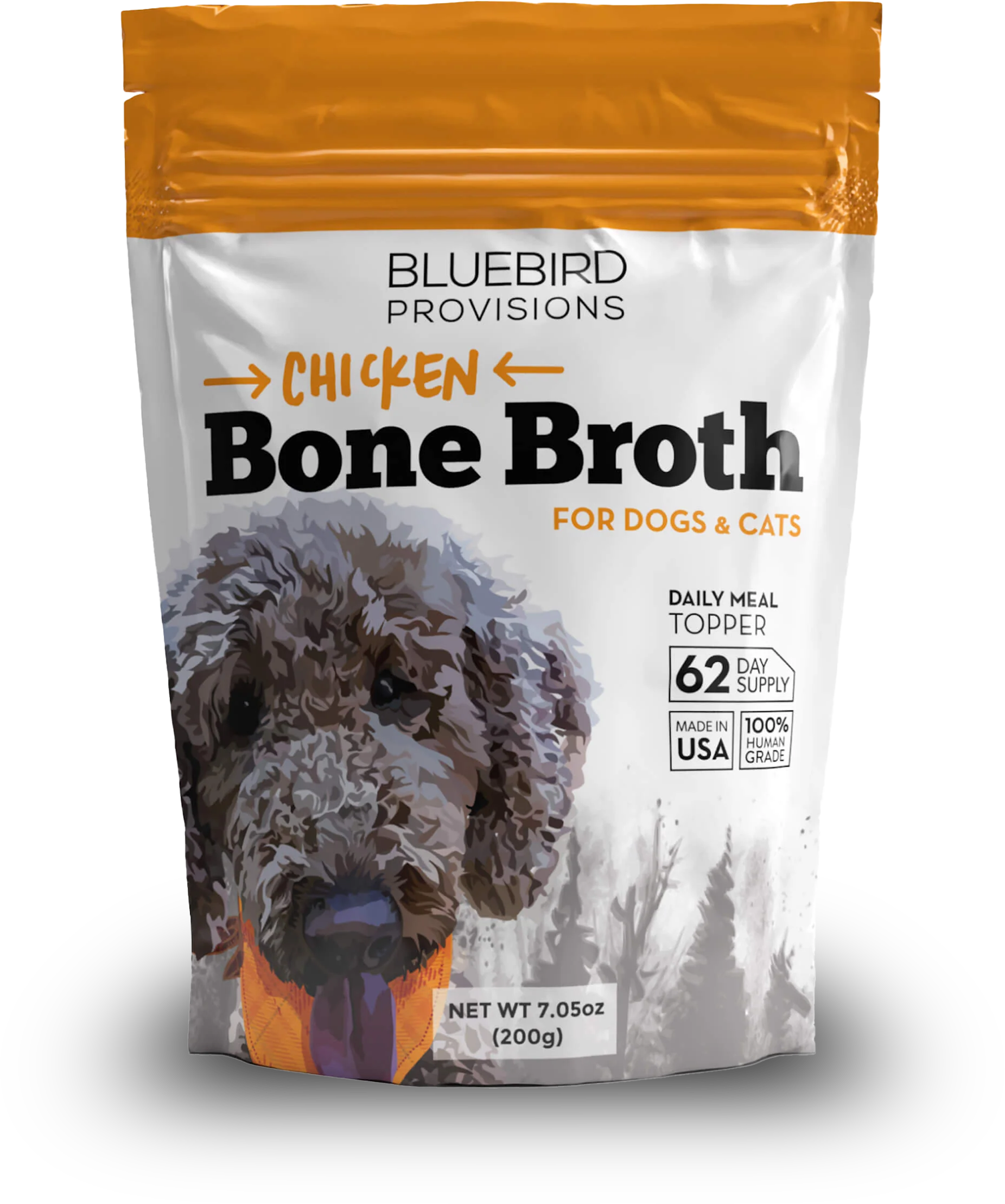
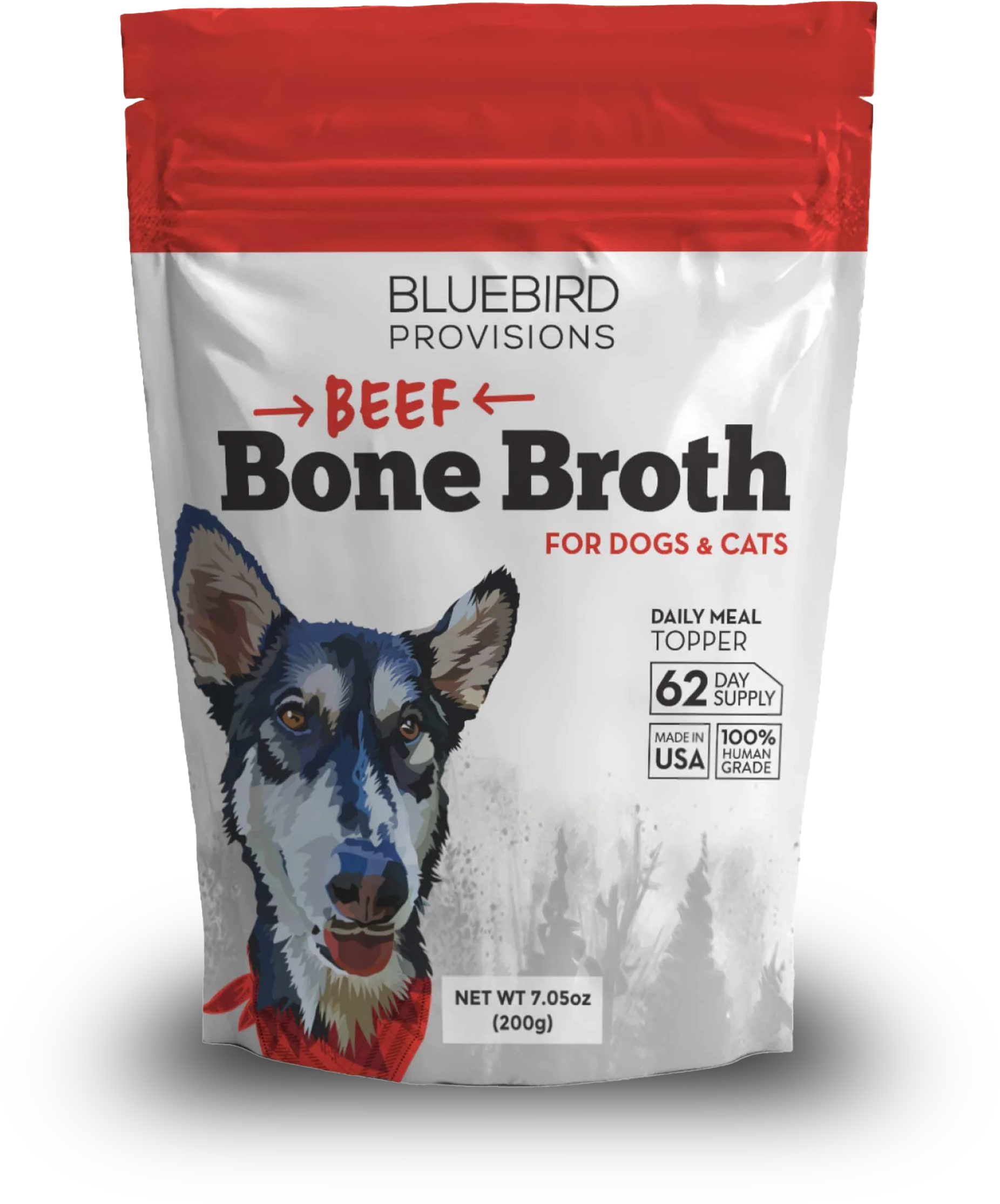

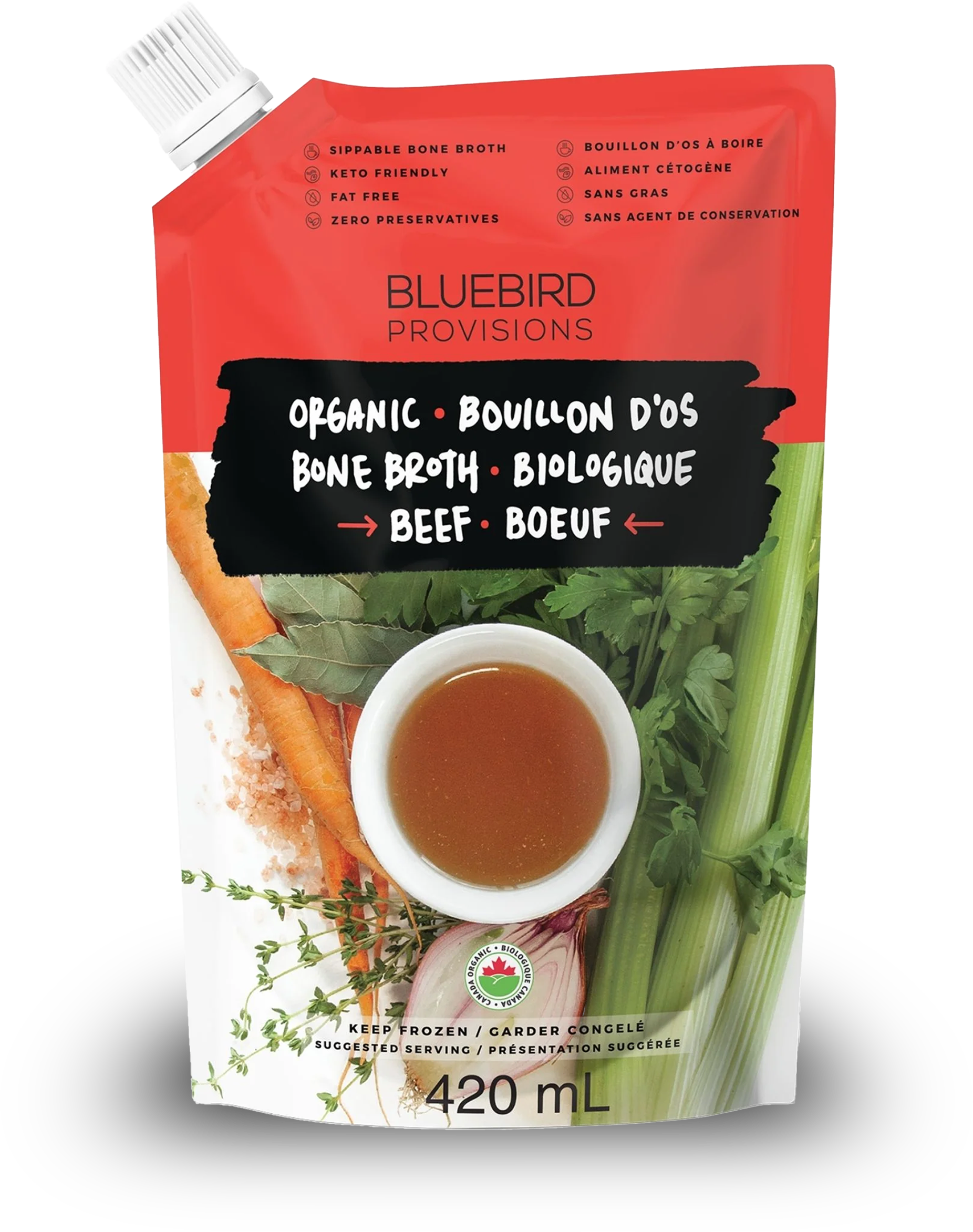




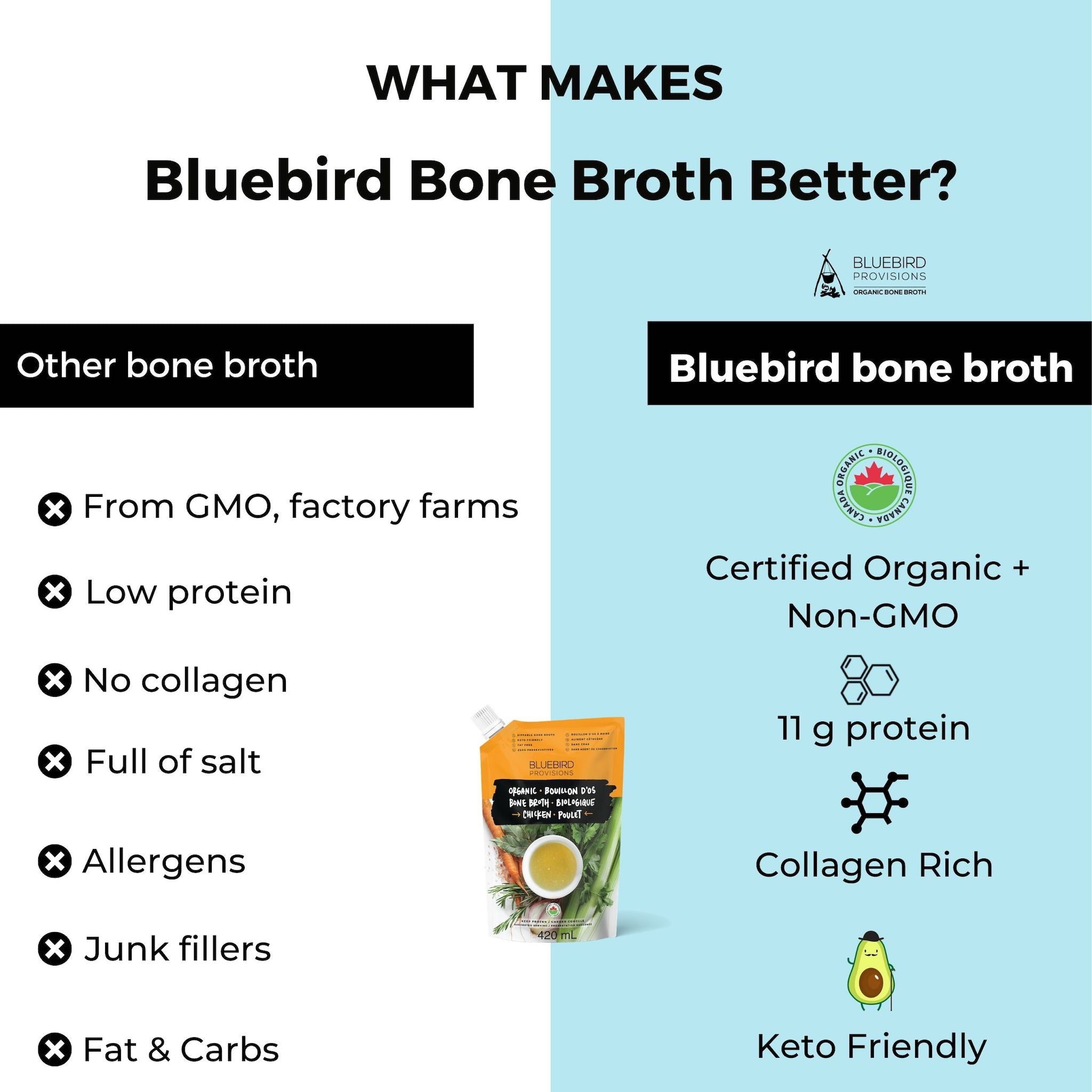
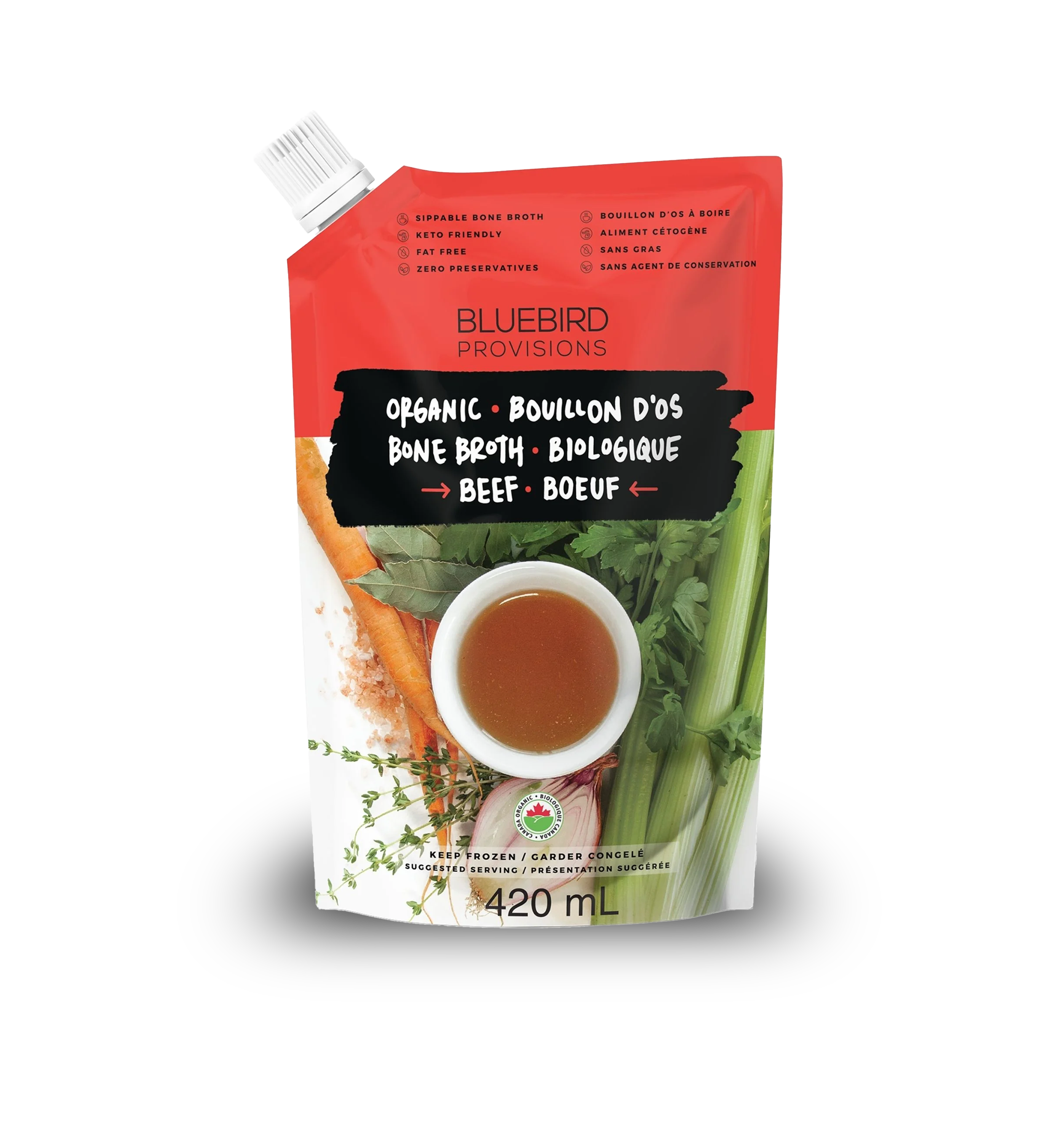
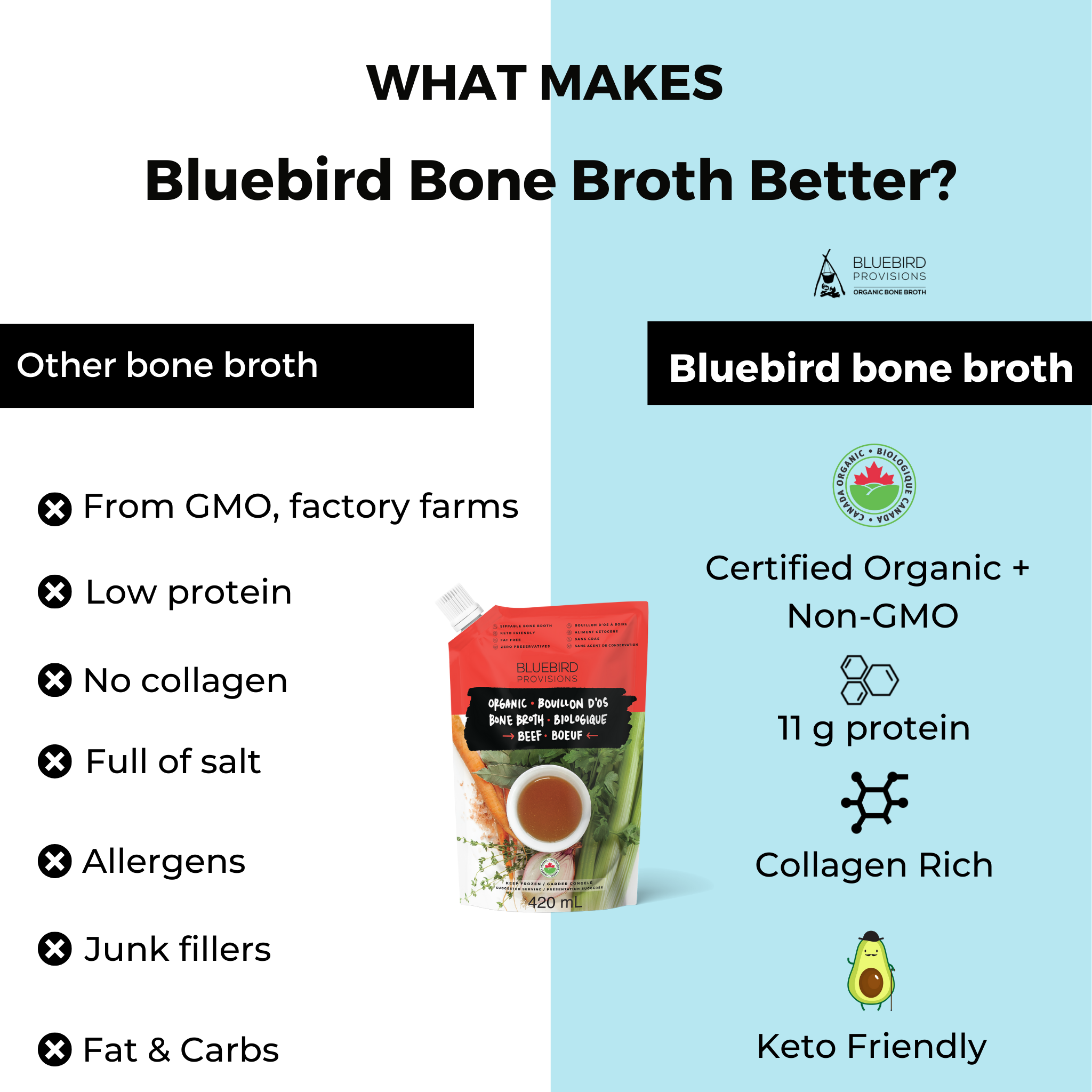
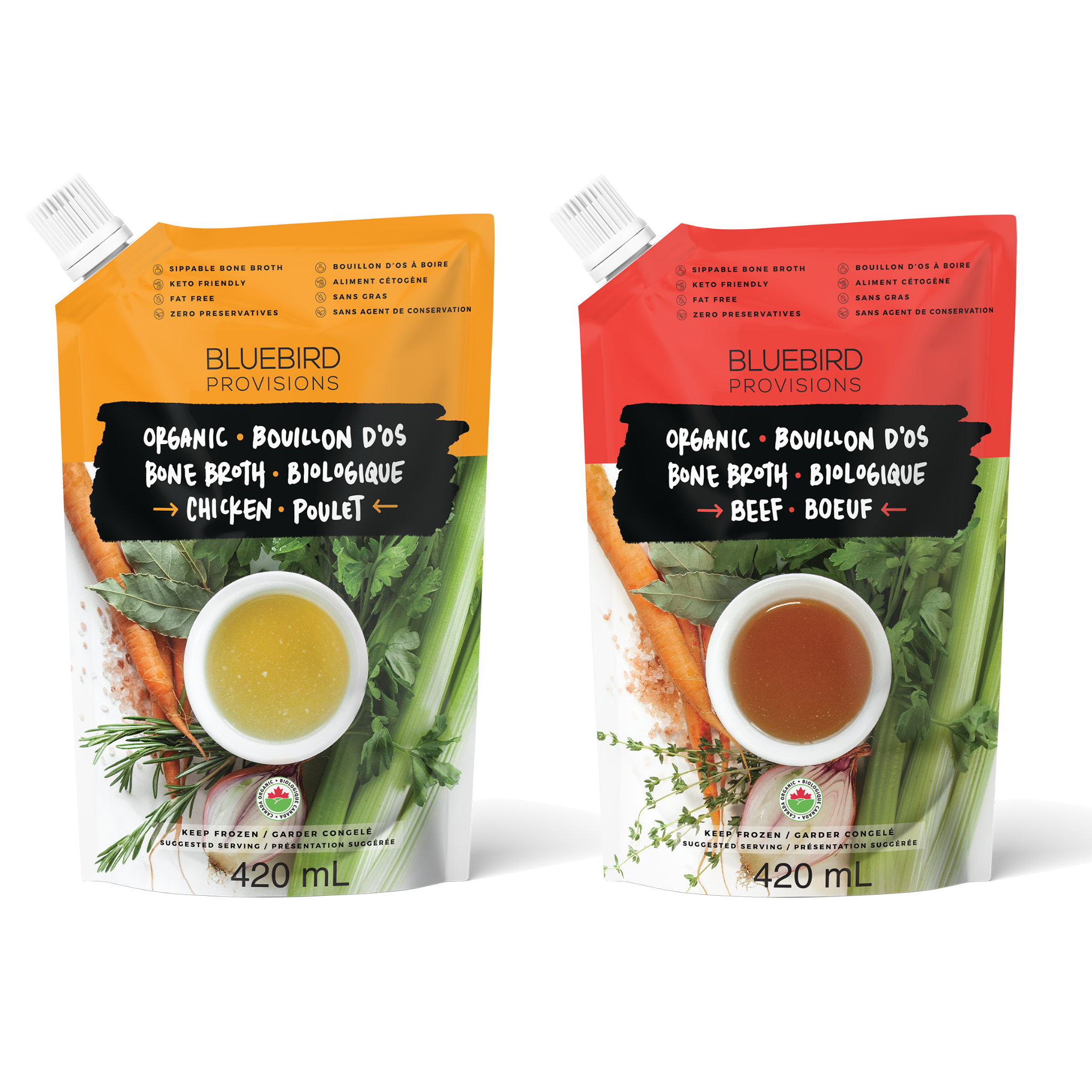
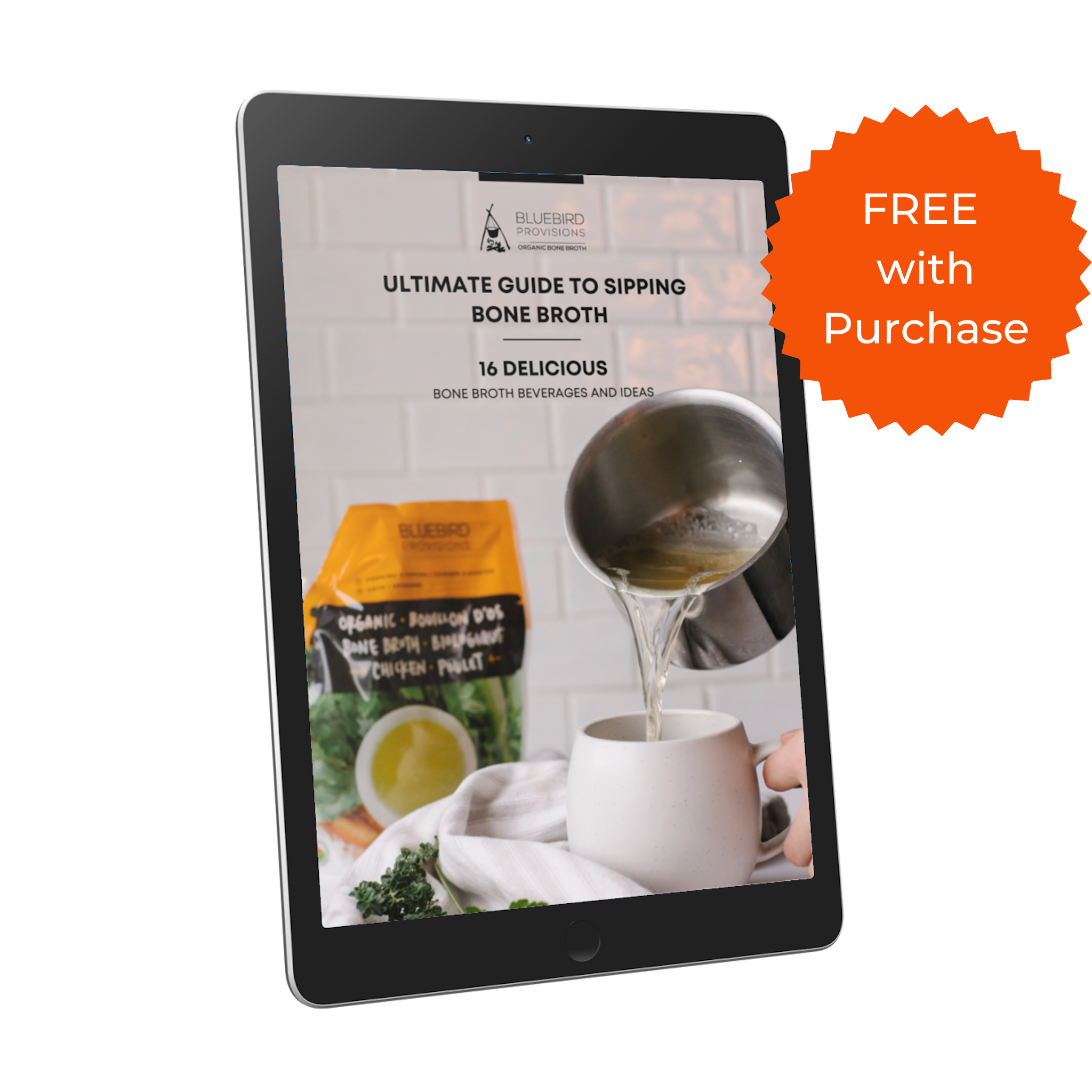
127 comments
Hi Monika, I’ll answer you questions below. Let me know if I missed anything.
Frozen meat depends on how much you have, but for home batches I would say 30 mins to 1 hour or so to get it boiling.
Once it is boiling I will lower to a rolling simmer / light boil.
I almost always have it on a rolling simmer the whole cook.
I use a gas stove, but electric works great too.
Connor
Connor at Bluebird Provisions
Hi Connor thanks a lot for the answer!
1. made many other broths last time and I found that the broth smells like chicken when I didn’t parboil in hot water and start with cold( I think it is because of quality of the meat what I can’t change just try various farmers…)
2.spicy taste is in my opinion some substances that are given into meat before packaging….some conservants….
3. I studied about danger zone temperatures and chicken is really specific, so I couldn’t start in cold water and must to parboil in hot water immediately from fridge before really cooking ( just for my sensitive stomach….)
than cool in ice and start again in cold water
4.these days I’m trying various methods, slow cooker doesn’t work very well, 3hours lasts to start really cooking…. instant pot release steam during proces to achieve stable pressure which makes it cloudy and you can’t do skimming, so I decide just cooking on the stove top
Yes my broth is cloudy after cooling and straining even through the coffee filter…I think about if there isn’ t a problem with my stove, it is very hard to manage simmering….I must stay around and still look at it…
Or water too hard,I can’t use filtered because of sodium in it…
I use thermometer now every cooking to get more information about my cooking….
When you put frozen meat into cold water how long it takes to bring it to a boil please?
Do you low the temperature immediately when it starts cooking ?
how long you let it on a high heat when it could be frozen in the middle of junks?
How stove do you use? Electric,gas or induction?
Very happy to have someone to ask for experience and advice!
Monika
Thanks for your questions Monika. I’ll do my best to address them here below.
I would start the broth on high heat to get a good boil for the first hour or so.
You don’t need to cut the meat up any smaller. Just keep it in big chunks as is.
In terms of toxins, I take the frozen meat and bones and put that straight into the pot with water. Then bring it all to a boil.
The spicy flavour is hard for me to give advice on. You might need to try different bones from a different farm.
As for cloudy broth. It will always be cloudy when you are cooking it. Is your broth still cloudy after it is strained and cooled?
You don’t need to remove the fatty bits from the bones / meat. I would just make sure you skim it well in the first hour and otehr than that, do not stir the broth.
Hope this helps and let me know how it goes.
connor
Connor at Bluebird Provisions
Hi Connor,
excuse me please again I write in peaces,I solve milky broth these days intensively ,trying to find where is mistake….
1.maybe a meat is too fatty,do you cut fat peaces from meat and bones?
2.or maybe quality of water, what water do you use in broth please?
filtered? can minerals or a chlorine affect an emulsification of fat? I saw yesterday when I put cold tap water into pot with chicken it immediately got cloudy before cooking, even when I few times washed the meat again…
thank you som much !
Monika
Hi
excuse me please a I have si many questions and write them in peaces….I noticed when I made my last chicken broth from whole chicken, that when I parboil it first the water isn’t cloudy, and after washing and replacing new cold water, when it starts boil it gets immediately milky,even if I skim,skim,skim….there is not much to skim just fat
Can you please explain or maybe just share if you have the same experience?
To have clear broth or stock it is better not to parboil?
Thanks a lot!
Monika
Dear Connor,
thank you so much for sharing with all this experience,I am doing meat and bone broth for years,but maybe wrong method…few months ago my stomach have started refuse broth, and I tried many techniques to avoid emulsified fat in broth,because I feel very full after that and sick etc…even when I cooled it and throw fat on the top away,still is hard to diggest for this times….
I made broth from chicken breast, it is very hard to find good source, I have read about white stripes and woody breast, bad conditions for animals….in my country is hard to find organic chicken meat and I worry about beef to be harder to diggest too.
I have some questions if you can please give me your opinion
1. what do you think, where could be problem,when I started broth on low or medium temperature with a cold water and raw meat, or cold water and parboiled but cooled and washed meat, the broth than taste and smell like wet alive chicken( terrible)
2. I have tried many sources of chicken meat, meat from farm, from store, various…but some of them makes broth spicy like I did put there pepper but I didn’t
Even when I cooked meat two hours and then put in new water and cooked again to avoid some conservants still spice
why could meat broth taste spicy when you put there just meat and water?
3. what is the most safe method to get rid of bacteria and toxins on the top of the meat, do you put frozen meat immediately from freezer in cold water and bring to quick hot boil,or better defrost in microwave or during night in fridge and put in cold water and quick boil or put meat fresh or defrosted or frozen into hot water to avoid danger temperature zone to minimum?
4. do you think it is better to cut a breast meat into smaller peaces or better cook whole parts, I noticed there is more milkyness when I cut it before
I have done skimming only after first boil,or washed meat after first boil and replace new water,so maybe there is the main reason I failed many times….
thank you so so much for everything!!!!
best wishes from Slovakia
Monika
Hi Mishayla,
Yes, we have a great recipe for that you can read here: https://bluebirdprovisions.co/blogs/news/instant-pot-bone-broth-recipe
connor
Connor at Bluebird Provisions
First off thank you soo much for this post! I drink bone broth everyday and have started looking into making it. I am wondering what your opinion is on using a pressure cooker ie. An instant pot is?
Mishayla Forschen
Hi David,
Thanks for pointing this out and I agree. I mentioned in the comments how ther is nothing wrong with milky broth. But I realize I called it ‘dreaded’ in the body of the article. It was meant to be tongue and cheek but I will edit it so others do not see it as negative.
Connor at Bluebird Provisions
I’m curious why you’d suggest that milky broth is inherently bad. There is a Korean bone broth called Seolleongtang. Its made with bones of leg, knee and feet with nothing else added and the desired result is a creamy, thick milky broth, which is actually can be a bit difficult to achieve correctly and its delicious.
David Ginsberg
Hi Ami,
In my experience roasting the bones will not make a meaningful nutritional difference.
Connor at Bluebird Provisions
Hello Connor! Thanks so much for this detailed and science backed article. I was wondering about roasting the bones beforehand – is it going to make any nutritional difference?
Ami
Looks like I’ve been making at least 2 of the 4 mistakes. I buy 10# bags of chicken leg quarters (60# at a time) to can the meat for our fur babies. In my area the 10# bags go on sale for $.55-60 per # which is a real bargain as far as I’m concerned, you certainly cannot get 10# of beef or pork for $6 give or take!
I boil the chicken first then remove the meat from the bones then can the meat (saving the nice looking chunks to can separate for making chicken and dumplings for us. Then I put the bones back in the water with my vegetables (onion, celery and carrots) lots of herbs (sage, bay, oregano, thmye and spicy Basil) and vinegar (oops). I skim but not quite enough because even though I strain it 3-4 times using the finest mesh I can find it’s not cloudy but ends up with some solids floating at the top of the jars. After all that I fry the skins in the skimmed chicken fat for fur baby treats. I end up throwing away just the spent bones so I get as much out of the chicken as possible. I will definitely be leaving ou the vinegar and skim a lot longer. Thanks for all the great info!
Tina Ward
Hi Amy, I’ve worked with a large company who was developing a Korean style bone broth that sold in restaurants in Korea.
I did a deep dive into the techniques and I am a fan. The milky texture has a lot of flavor (although it looks less appetizing to most North Americans).
I would go for it!
connor
Connor at Bluebird Provisions
What do you think of the Korean way to make bone broth? They boil the bones (I’m referencing beef tail and leg) for about 10 to 20 minutes, dump out the water wash the bones and pot and then refill and boil the heck out of it to get the milky white broth for soups. Although I disagree with them about scooping out and adding more water. I just boil the bones to honey comb and add water when the level gets low. Please check some Korean videos and respond? Like Maangchi.com or Kimchimari, or others.
Amy
After the broth cools to room temp, I place a large bowl on top with a good amount of ice, make sure the bowl touches at least one inch of the broth. Have 2 more bowls handy. One to switch with the ice while you scrape the congeles fat into the 3rd bowl. Now store in containers.It worked perfectly for me. Enjoy.
Lupe
Hi Martin,
Yes you are right about the lid and water reduction. Reducing it (with lid off) will usually yield a stronger broth. But you can simply drink more of a weaker broth to get the same effect.
I would keep doing what you are doing!
connor
Connor at Bluebird Provisions
Hi Connor, thank you for a very informative article!
I have a question regarding water to bone ratio and reducing. I make bone broth in my stockpot on the stove, and I put enough water in to just cover the bones. I don’t want to remove the lid. First of all because of the smell, and second of all I don’t want to reduce the bone broth while the bones are still in it, as I want them covered with water.
So the question is wether I should reduce the liquid after removing the bones. Am I right in assuming that the total amount of gelatin is the same in the weaker unreduced broth as in reduced broth? If so, can’t I just drink more of it and get the same benefits even if it doesn’t turn to gel when cooled?
Martin
Hi, thank you for posting this informative article! I’ve always wondered about the apple cider vinegar. I’ve even heard of adding a tablespoon of baking soda at the beginning of the simmer stage.
I’ve been making my bone broths for years even before broth became a raving health trend. My mother always started her soups with a rich bone stock, she never had any health problems and gave all the credit to her soup! Making scratch bone broth is time consuming so I will purchase some of these broth packs from BBP as they will definitely come in handy.
I recently used oxtail bones. The finished broth/stock rendered a rich, mouthy flavor, unlike any other beef bones I’ve used.
An extra step may have been a contributing factor for the flavor- I gave the oxtails a sea salt rub then browned them in the oven for a short time. This also seemed to eliminate the need for constant skimming.
Sheryl
Hi Cristi,
you can make delicious bone broth in a pressure cooker. Checkout this recipe: https://bluebirdprovisions.co/blogs/news/instant-pot-bone-broth-recipe
Connor at Bluebird Provisions
Ok guys firstly I am Jewish and for those who makes there broth a good time is right before Shabbat starts and let it cook on level LOW in the crock pot I guess it could be HIGH to draw out the collagen. I added celery carrots onions rosemary and garlic. Three packs of chicken bones KOSHER at 2.50 each . And filled the water level 2" to 3" above the whole thing. Ok the result was a weak watery broth. Next time I will less water as suggested. But the next day I read an article that you should blend the remainder of the mix bones and vegetables and the broth and place in those soup jars. So I reheated the mix and WOW what a difference. Not sure exactly if it’s safe to drink I will find out later today ie toilet run ;). Cheers
Sf
Hello,
I’m new to making bone broth. My brother uses his instant pot (cook at high pressure for 3 hours). Since it is in a pressure cooker, I did not do any skimming. Will pressure cooking like this produce a good bone broth? Thanks!
Cristi
Thanksgiving time: My mother always took the roaster with gravy and dressing scraps and dumped all the bones and carcass into it. She added onions and celery. added water to almost cover bones and let it simmer all night. after cooling the next day we used a big slotted scoop to remove big stuff. Big pieces meat were saved for the soup. We then used a strainer to remove small bits of bone and other solids. She would Pour it into quart jars, leaving head room, and freeze. scraps of meat were added to the jars also.. We continue the tradition. Experimenting I have found I can make a tasty broth by saving the bones from roasted or grilled chicken and when I have enough i boil it as with the turkey. Have a pot of beef scraps and bone simmering now. Not so easy to get beef with bone.
Pat Childs
Hi Luke, I am not familiar with insulted cooking. How much heat is there in this method?
Regarding pressure cookers, they work great. You can see my recipe here: https://bluebirdprovisions.co/blogs/news/instant-pot-bone-broth-recipe
Connor at Bluebird Provisions
Hi Christine,
There is nothing wrong with cloudy broth from a taste or nutrient perspective. In Korea and Japan, they exclusively prefer cloudy broths. I would drink it!
As fort he collage without the gel, it just means you have less protein and collagen per cup of broth.
If yours does not gel at all, you most likely have 2-5 g of collagen protein per cup. With a little bit of gel closer to 5-7 g. And a full gel you will have 8+ grams per cup.
hope this helps.
Connor at Bluebird Provisions
Hi, thanks for the write-up
I am 38 and just following shoulder surgery – turns out I got a lot of osteoarthritis going on in there too! – I’ve been looking into sources of collagen type 2 to slow down the need for a new shoulder.
So I’m planning to make chicken bone broth. I can get cheap bones, but it seems to be very energy-intensive cooking.
I was wondering about your view of insulated cooking ie, heat and boil for 30 mins then leave in a heavily insulated container for 24 hours…. then maybe repeat.
If I was to try insulated cooking how would I test to see if I am indeed harvesting the collagen?
Also how quickly would it be possible to achieve the same results as you with a pressure cooker on the stove top set to high?
Any help would be greatly appreciated
Thanks
Luke
Luke
Thanks for the article, Connor!
I had a couple of questions please.
I’ve read all over that I shouldn’t want cloudy broth – from a health-only perspective (taste doesn’t bother me) is cloudy ‘bad’ or still fine to drink?
Secondly, everyone keeps saying it should turn to gel. If too much water is added this won’t happen but will the collagen still be extracted the same either way? I don’t want to eat gel, mine tastes and looks like soup – am I still getting collagen at the same level, albeit not as concentrated?
Thanks :)
Christine
Christine
To the bluebirdprovisions.co administrator, Your posts are always well-referenced and credible.
Freya Caro
Hi Myrtle,
Yes this is how I do it when i make it at home as well. The bonus of the fat cap that forms as it cools is preservation.
It will keep longer in the fridge if you do not remove the fat cap.
Connor at Bluebird Provisions
Hi Kathleen, yes you can absolutely use it!
Connor at Bluebird Provisions
Hi Lisa,
In your case you do not need to roast them a second time.
Connor at Bluebird Provisions
After simmering my bone broth for 24 hours in a slow cooker, I refrigerate it overnight and remove the layer of fat that forms on the surface. The beef fat is very solid and easily lifted off. The chicken fat is a little softer but still easily removed. There’s always a lot of fat. Does anyone else do this?
Myrtle Balderson
Hi
u mention ACV not impacting the calcium etc, but what about the protein and gelatin levels in the broth! that is the whole point of the broth.
So does it affect?
thanks
dan
Can you use a prosciutto bone for bone broth?
Kathleen Mooney
I often make bone broth using chicken carcasses and drumsticks. My question: if the chicken and drumsticks have been roasted with the meat on to consume for a meal, do I need to roast them again after the meat is removed? I’m assuming the blanching and roasting directions apply to raw bones.
Lisa
Hi Hannah,
I think in your case you had the temperature on too low so that the fat did not rise to the surface. The fat, form and oil should always be on the surface, or else it is not hot enough.
hope this helps and let me know how it goes.
Connor at Bluebird Provisions
Hi Sherry, yes I am familiar with what you are referring to. I’ve written at length about it in this article: https://bluebirdprovisions.co/blogs/news/is-bone-broth-bad-for-you
There are a few recommendations in there you can try. But mainly you need to cut your consumption to 1/8th of what you tried before or else it might not be a fit for you.
please let me know how it goes.
connor
Connor at Bluebird Provisions
Hi Megan, thanks for sharing you info!
In my experience in troubleshooting, it is almost always a bones to water ratio issue when it comes to weak broth.
Consider waiting until you have 3-4 chicken carcasses or supplement a carcass with lots of chicken feet, wings and drumsticks. This should work.
If you are using a slow cooker, I would recommend it on high.
hope this helps and let me know how it goes!
connor
Connor at Bluebird Provisions
Hi,
I made bone broth for the first time a couple days ago. Followed the advice on this page to skim during the first two hours, except there was not much to skim! I did do this in a slow cooker and had it on low for basically half the night (I’m an insomniac). It still ended up very cloudy even though there were no fat or meat bits to take off. Would you know what I did wrong?
Hannah
Hello:
I am wondering if cooking on high heat for long period if time is the ONLY way to get what you called “beneficial” healing broth. I ask because I have a strong sensitivity to anything thays starts with “gluta…”
Now this could be different, but I bought a processed bone broth powder from Dr. Josh Axe. I used half the recommended serving size. It caused a very negative neurological response. I have a friend that it happens to as well. Glutamine turns into Glutamate in the body. A known neurotoxin for a lit 8f people. So it was recommended to cook low (heat) and less hours when making homemade. High heat for longer periods creates the glutamine release. But I NEED the benefits. Thoughts?
Sherry Mathison
Hi there. Thank you for these tips. I kept wondering why I’d seen so many broths requiring ACV when I hadn’t added it before, though I hadn’t made my own bone broth in awhile and also wondered if I had forgotten that ingredient and if it had anything to do with why my broth turned like a thin, grey-green brown instead of the nice thick golden brown I normally achieve. Would you please help me troubleshoot?
I also used an Instant Pot on Pressure Cook (2 hrs on high), though I used to use a slow cooker on low (about 8 hrs), and wonder if that could be the issue. The other thing I did different was add fresh herbs (thyme & sage) in addition to the vegetables (onion, carrot, celery) l usually use, so maybe the herbs broke down too much? My other guess is that I didn’t have enough bones. I usually freeze a couple-few chicken carcasses to get enough or use a turkey one, but this time I only had the carcass and not even all the bones of one 5 lb chicken.
I’d appreciate any advice you could give. My own thought is to go back to Sally Fallon & do some rereading. ;)
Megan Holland
Hi J.Fox,
That is great that you like cloudy broth with all the fat. By all means don’t listen to my advice then.
Connor at Bluebird Provisions
Hi Arlene,
The olive oil will not have any effect on the bone broth. IT should add a bit of nice flavor.
Regarding the chicken, I am assuming it was 5 lb with all the meat on it? Now it is likely substantially less with the meat removed. Maybe 2 lbs or so.
This might not be enough to get be worth your effort. You can make a good bone broth with it, but you won’t get a lot of it.
I would freeze it and wait until you have another carcass to use.
Connor at Bluebird Provisions
I don’t agree with any of this. Especially the skimming part, keto lifestyle folks want that fat etc… I don’t give a crap about cloudy broth!
J.Fox
Greetings, Connor! I have never made bone broth. I was thinking about making some chicken bone broth. But after reading your posts I am not sure I have enough bones. I roasted a 5 lb cutup organic fryer in the oven tonight. I removed most of the meat off the bones as I want to use the chicken in chicken salad and probably in a couple other dishes. I kept the bones in a plastic bag. THere is still a little meat on the bones here and there, like in the back and the neck which . And then I have another bag containing some dark meat scraps, and skin. I had brushed a little olive oil on the skin before baking, btw.. Since making the bone broth is basically an after thought, but if it is possible to proceed, I sure would like do that… This chicken cost me about $25 so I sure would like to use it to the fullest. So right now I have 3 containers in the fridge. A container of nice tender cooked chicken, a bag with the bones from the one chicken…and a bag of scraps and skin. I have a large soup pan to use on the stove top. And I have celery, carrots, and onions…and some fresh parsley and rosemary growing in pots in my kitchen and a big assortment of dried herbs and spices. available . My first question is this… Do you think the bones from this one 5 lb chicken is enough to work with or would you recommend me freezing them and adding more to them before attempting bone broth. (No chicken feet ) And 2nd question… did me brushing the skin with a little olive oil before baking the chicken ruin my chances for successful bone broth?
Arlene
Hi Venessa,
Yes I am curious as well. Magnesium (and most other minerals) levels are very low in bone broth, so my educated opinion is that there may be a 10% or so difference. But the total number is so low that it makes no real difference when it comes to your individual RDA for magnesium (or any other mineral) per day. a 10% increase of a very small number is still a very small number.
As for not listing more vitamins and minerals. Yes you are correct, it gets very expensive and you are charged for each mineral you test for. We are a small business and can’t really afford to test everything.
As for collagen my hunch is that it would not change base on my experience looking at our lab results over the years. It is more about the connective tissue you are using to make it than any acid.
Connor at Bluebird Provisions
Hello! Thank you for this article. I am curious if there were any changes in collagen connect with added ACV, because that is why I heard you should add it, not calcium, but that is not included. Also, magnesium would be interesting to see, and as many nutrients as possible, really, as there are many dozens potentially available in foods. I don’t know what the process is to check each nutrient, so maybe it is a cost, time, equipment, etc., issue?
Venessa
Hi David, woah I love your story so much. You are such a thoughtful and generous human to do that.
Sounds like you’ve got the nutrition recipe nailed to make some potent bone broth!
Connor at Bluebird Provisions
Hi Terry,
Yes in your case I Would cook it for 3 hours then remove the lid safely and skim all the fat then.
Connor at Bluebird Provisions
Hi Hilary,
I am not familiar with using blood in bone broth. I wish I had an answer for you but I don’t. You can try it and let me know how it goes.
connor
Connor at Bluebird Provisions
Leave a comment
This site is protected by hCaptcha and the hCaptcha Privacy Policy and Terms of Service apply.